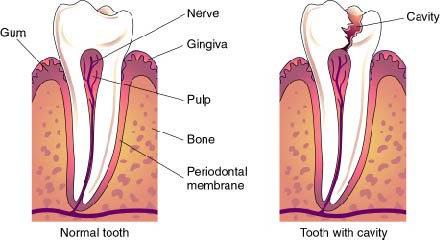
When we tell our patients that they have a cavity, they often respond, “but I don’t feel anything” or “it doesn’t hurt”. Well, that’s usually a good thing because the chances are, if you feel pain from decay, you need more than just a filling.
There are 3 layers to every tooth; the enamel, the dentin, and the nerve (pulp). The enamel is the hard, white outer coating of the tooth. We like to compare it to having the consistency of glass. The dentin, or middle layer, is softer and more porous, having the consistency of a pencil eraser. And the nerve, or pulp, is the blood supply and vitality of the tooth. The dentist can drill through the enamel with no discomfort. It is when the dentist hits the dentin, that the patient can feel a sensation in the tooth. This is because the dentin contains channels going to the nerve of the tooth. Bacteria work very hard to get through the glassy enamel, but when decay reaches the soft dentin, it is able to spread much more quickly.
In dentistry, we like to work preventively… Keep cavities from happening. However, when they do, we like to catch them in their early stages. It is only when a cavity gets deep into the dentin, and close to the nerve, that you can begin to feel pain from decay. Once you start feeling pain, the tooth may need more than a filling to repair the damage. If decay reaches the nerve of the tooth, the tooth becomes infected and the nerve of the tooth dies. Further treatment to the nerve of the tooth is then needed. So it is very important to have cavities filled in their early stages. This will allow your dentist to keep your fillings small and to preserve more tooth structure, and prevent you from needing a more invasive treatment.
